Developing Manager: Management Styles, Skills and Career Planning
VerifiedAdded on 2024/06/07
|24
|5922
|408
Report
AI Summary
This report provides an analysis of management principles, focusing on the development of managerial skills and career planning. It compares management styles at Virgin Holidays and Thomas Cook, examining leadership characteristics, communication processes, and organizational culture. The report includes a personal SWOT analysis to identify strengths, weaknesses, opportunities, and threats, with prioritized objectives for potential development. It also addresses team motivation and decision-making strategies for achieving goals, alongside a review of managerial and personal skills essential for career advancement. The ultimate aim is to create a personal development plan aligned with future career needs. Desklib offers a wealth of resources, including solved assignments and past papers, to support students in their academic and professional journeys.
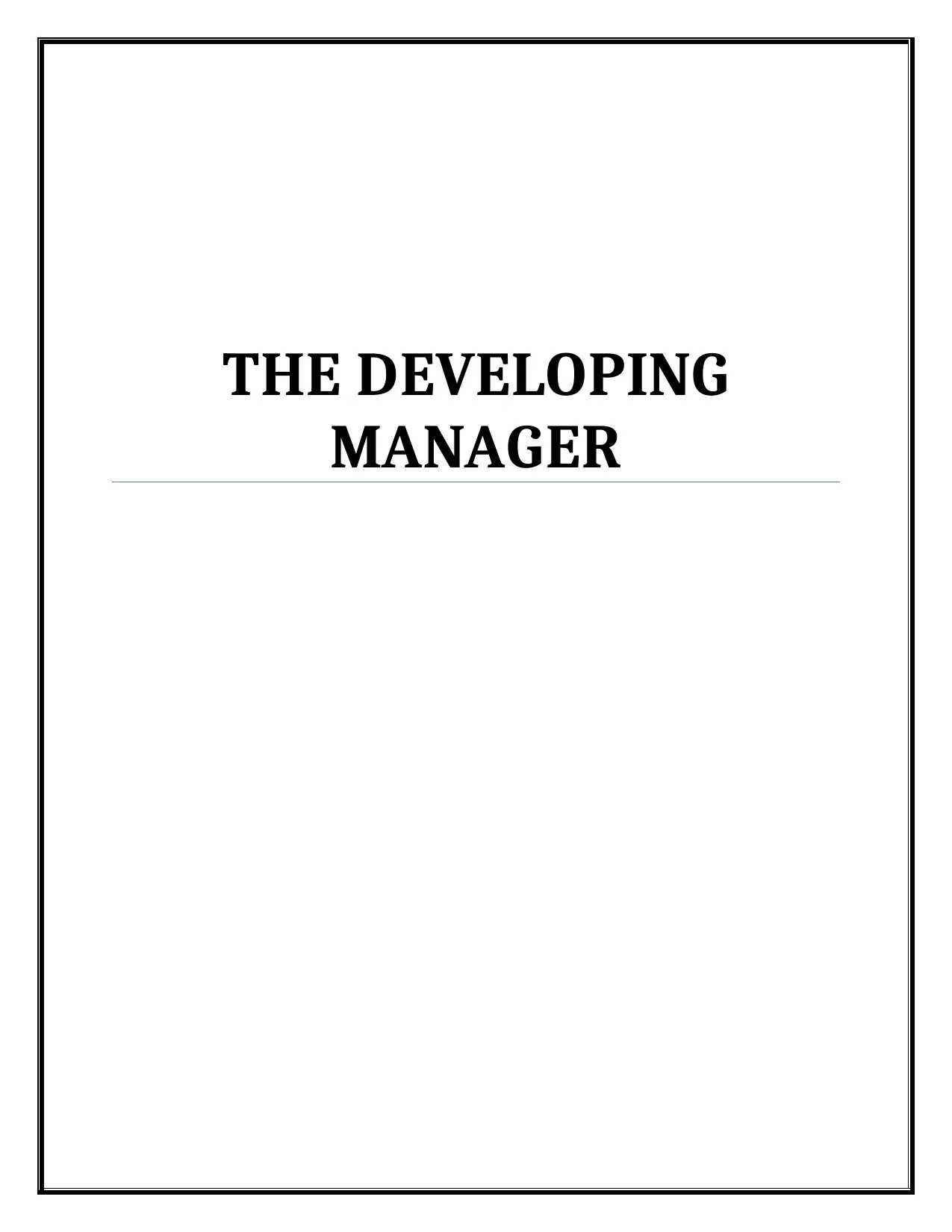
THE DEVELOPING
MANAGER
MANAGER
Paraphrase This Document
Need a fresh take? Get an instant paraphrase of this document with our AI Paraphraser
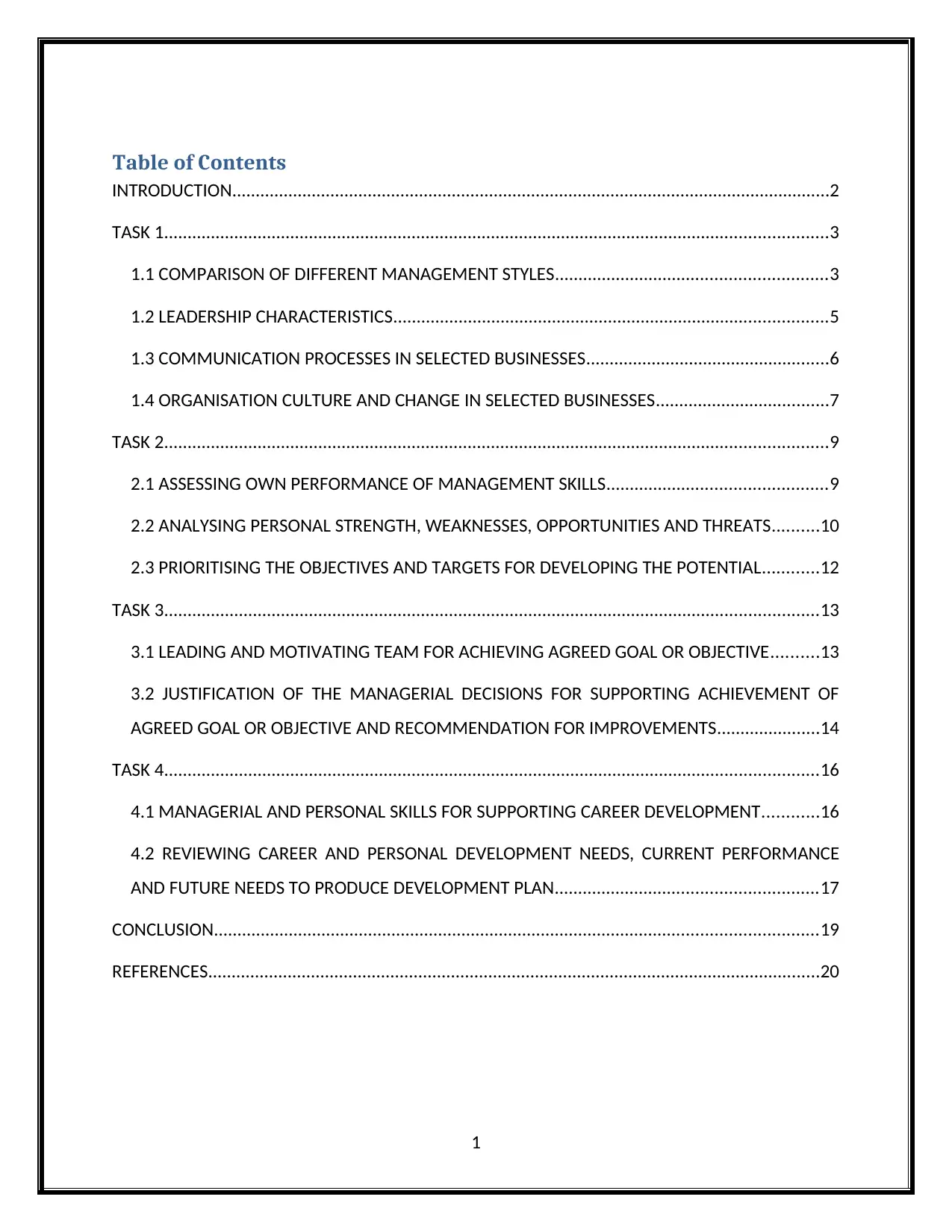
Table of Contents
INTRODUCTION................................................................................................................................2
TASK 1..............................................................................................................................................3
1.1 COMPARISON OF DIFFERENT MANAGEMENT STYLES..........................................................3
1.2 LEADERSHIP CHARACTERISTICS.............................................................................................5
1.3 COMMUNICATION PROCESSES IN SELECTED BUSINESSES....................................................6
1.4 ORGANISATION CULTURE AND CHANGE IN SELECTED BUSINESSES.....................................7
TASK 2..............................................................................................................................................9
2.1 ASSESSING OWN PERFORMANCE OF MANAGEMENT SKILLS...............................................9
2.2 ANALYSING PERSONAL STRENGTH, WEAKNESSES, OPPORTUNITIES AND THREATS..........10
2.3 PRIORITISING THE OBJECTIVES AND TARGETS FOR DEVELOPING THE POTENTIAL............12
TASK 3............................................................................................................................................13
3.1 LEADING AND MOTIVATING TEAM FOR ACHIEVING AGREED GOAL OR OBJECTIVE..........13
3.2 JUSTIFICATION OF THE MANAGERIAL DECISIONS FOR SUPPORTING ACHIEVEMENT OF
AGREED GOAL OR OBJECTIVE AND RECOMMENDATION FOR IMPROVEMENTS......................14
TASK 4............................................................................................................................................16
4.1 MANAGERIAL AND PERSONAL SKILLS FOR SUPPORTING CAREER DEVELOPMENT............16
4.2 REVIEWING CAREER AND PERSONAL DEVELOPMENT NEEDS, CURRENT PERFORMANCE
AND FUTURE NEEDS TO PRODUCE DEVELOPMENT PLAN........................................................17
CONCLUSION.................................................................................................................................19
REFERENCES...................................................................................................................................20
1
INTRODUCTION................................................................................................................................2
TASK 1..............................................................................................................................................3
1.1 COMPARISON OF DIFFERENT MANAGEMENT STYLES..........................................................3
1.2 LEADERSHIP CHARACTERISTICS.............................................................................................5
1.3 COMMUNICATION PROCESSES IN SELECTED BUSINESSES....................................................6
1.4 ORGANISATION CULTURE AND CHANGE IN SELECTED BUSINESSES.....................................7
TASK 2..............................................................................................................................................9
2.1 ASSESSING OWN PERFORMANCE OF MANAGEMENT SKILLS...............................................9
2.2 ANALYSING PERSONAL STRENGTH, WEAKNESSES, OPPORTUNITIES AND THREATS..........10
2.3 PRIORITISING THE OBJECTIVES AND TARGETS FOR DEVELOPING THE POTENTIAL............12
TASK 3............................................................................................................................................13
3.1 LEADING AND MOTIVATING TEAM FOR ACHIEVING AGREED GOAL OR OBJECTIVE..........13
3.2 JUSTIFICATION OF THE MANAGERIAL DECISIONS FOR SUPPORTING ACHIEVEMENT OF
AGREED GOAL OR OBJECTIVE AND RECOMMENDATION FOR IMPROVEMENTS......................14
TASK 4............................................................................................................................................16
4.1 MANAGERIAL AND PERSONAL SKILLS FOR SUPPORTING CAREER DEVELOPMENT............16
4.2 REVIEWING CAREER AND PERSONAL DEVELOPMENT NEEDS, CURRENT PERFORMANCE
AND FUTURE NEEDS TO PRODUCE DEVELOPMENT PLAN........................................................17
CONCLUSION.................................................................................................................................19
REFERENCES...................................................................................................................................20
1
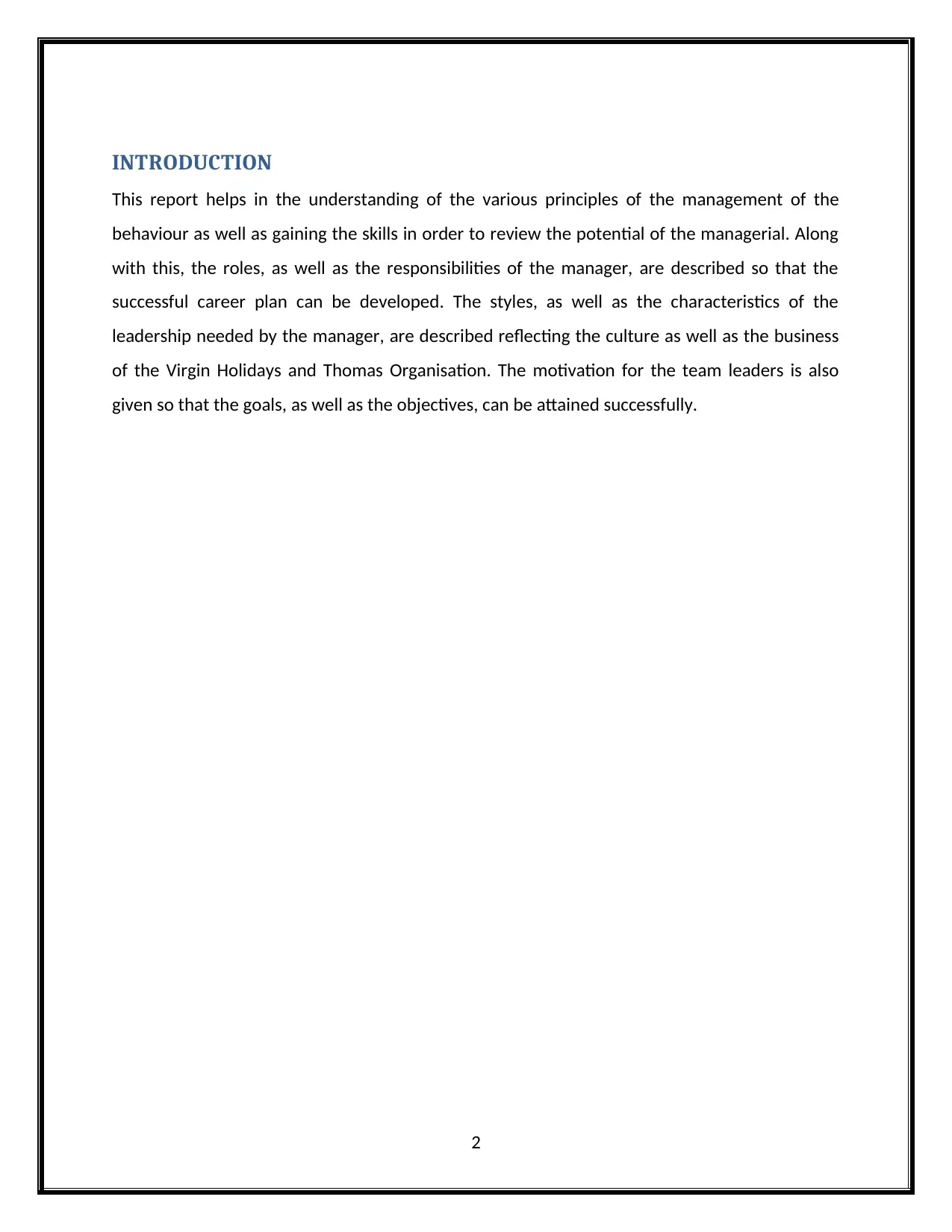
INTRODUCTION
This report helps in the understanding of the various principles of the management of the
behaviour as well as gaining the skills in order to review the potential of the managerial. Along
with this, the roles, as well as the responsibilities of the manager, are described so that the
successful career plan can be developed. The styles, as well as the characteristics of the
leadership needed by the manager, are described reflecting the culture as well as the business
of the Virgin Holidays and Thomas Organisation. The motivation for the team leaders is also
given so that the goals, as well as the objectives, can be attained successfully.
2
This report helps in the understanding of the various principles of the management of the
behaviour as well as gaining the skills in order to review the potential of the managerial. Along
with this, the roles, as well as the responsibilities of the manager, are described so that the
successful career plan can be developed. The styles, as well as the characteristics of the
leadership needed by the manager, are described reflecting the culture as well as the business
of the Virgin Holidays and Thomas Organisation. The motivation for the team leaders is also
given so that the goals, as well as the objectives, can be attained successfully.
2
⊘ This is a preview!⊘
Do you want full access?
Subscribe today to unlock all pages.

Trusted by 1+ million students worldwide
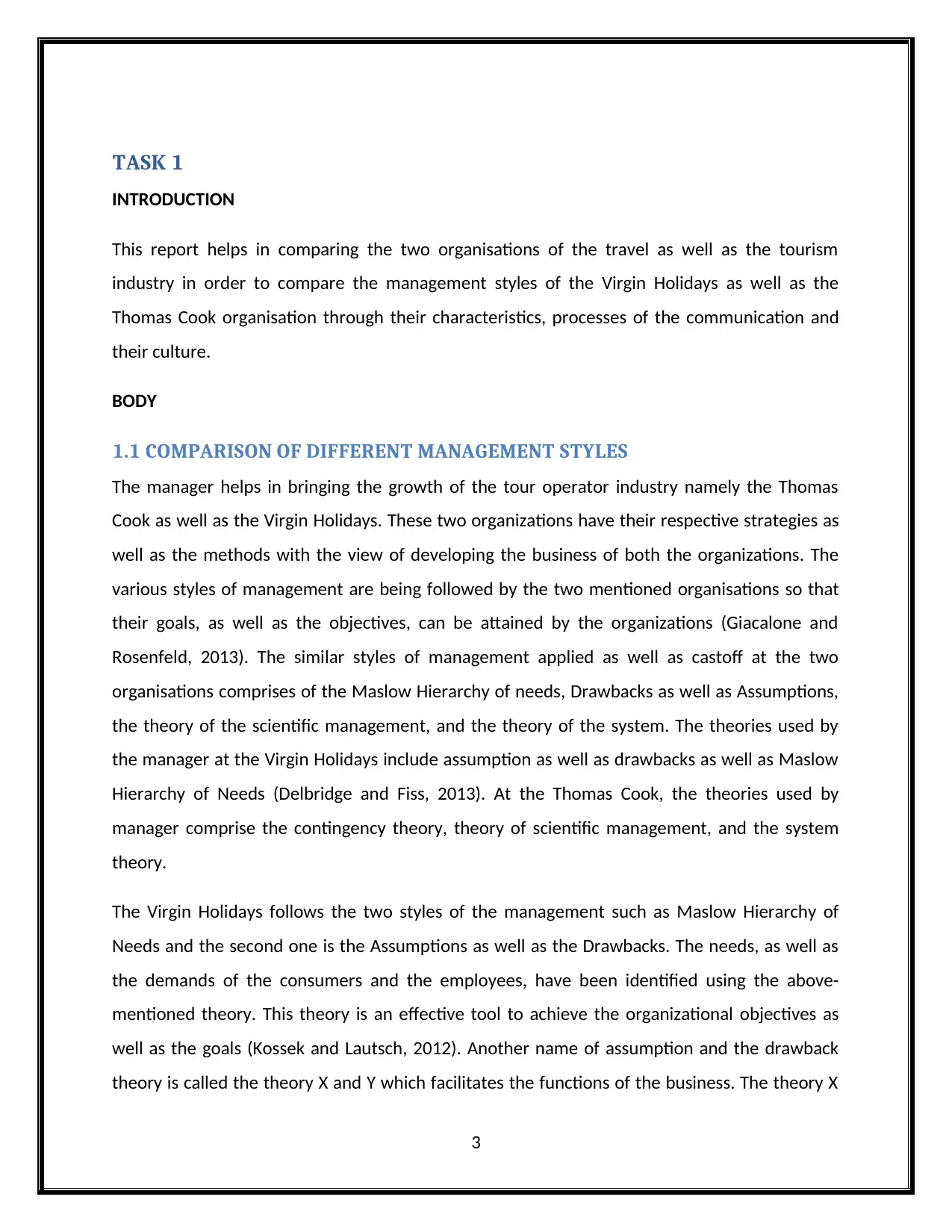
TASK 1
INTRODUCTION
This report helps in comparing the two organisations of the travel as well as the tourism
industry in order to compare the management styles of the Virgin Holidays as well as the
Thomas Cook organisation through their characteristics, processes of the communication and
their culture.
BODY
1.1 COMPARISON OF DIFFERENT MANAGEMENT STYLES
The manager helps in bringing the growth of the tour operator industry namely the Thomas
Cook as well as the Virgin Holidays. These two organizations have their respective strategies as
well as the methods with the view of developing the business of both the organizations. The
various styles of management are being followed by the two mentioned organisations so that
their goals, as well as the objectives, can be attained by the organizations (Giacalone and
Rosenfeld, 2013). The similar styles of management applied as well as castoff at the two
organisations comprises of the Maslow Hierarchy of needs, Drawbacks as well as Assumptions,
the theory of the scientific management, and the theory of the system. The theories used by
the manager at the Virgin Holidays include assumption as well as drawbacks as well as Maslow
Hierarchy of Needs (Delbridge and Fiss, 2013). At the Thomas Cook, the theories used by
manager comprise the contingency theory, theory of scientific management, and the system
theory.
The Virgin Holidays follows the two styles of the management such as Maslow Hierarchy of
Needs and the second one is the Assumptions as well as the Drawbacks. The needs, as well as
the demands of the consumers and the employees, have been identified using the above-
mentioned theory. This theory is an effective tool to achieve the organizational objectives as
well as the goals (Kossek and Lautsch, 2012). Another name of assumption and the drawback
theory is called the theory X and Y which facilitates the functions of the business. The theory X
3
INTRODUCTION
This report helps in comparing the two organisations of the travel as well as the tourism
industry in order to compare the management styles of the Virgin Holidays as well as the
Thomas Cook organisation through their characteristics, processes of the communication and
their culture.
BODY
1.1 COMPARISON OF DIFFERENT MANAGEMENT STYLES
The manager helps in bringing the growth of the tour operator industry namely the Thomas
Cook as well as the Virgin Holidays. These two organizations have their respective strategies as
well as the methods with the view of developing the business of both the organizations. The
various styles of management are being followed by the two mentioned organisations so that
their goals, as well as the objectives, can be attained by the organizations (Giacalone and
Rosenfeld, 2013). The similar styles of management applied as well as castoff at the two
organisations comprises of the Maslow Hierarchy of needs, Drawbacks as well as Assumptions,
the theory of the scientific management, and the theory of the system. The theories used by
the manager at the Virgin Holidays include assumption as well as drawbacks as well as Maslow
Hierarchy of Needs (Delbridge and Fiss, 2013). At the Thomas Cook, the theories used by
manager comprise the contingency theory, theory of scientific management, and the system
theory.
The Virgin Holidays follows the two styles of the management such as Maslow Hierarchy of
Needs and the second one is the Assumptions as well as the Drawbacks. The needs, as well as
the demands of the consumers and the employees, have been identified using the above-
mentioned theory. This theory is an effective tool to achieve the organizational objectives as
well as the goals (Kossek and Lautsch, 2012). Another name of assumption and the drawback
theory is called the theory X and Y which facilitates the functions of the business. The theory X
3
Paraphrase This Document
Need a fresh take? Get an instant paraphrase of this document with our AI Paraphraser
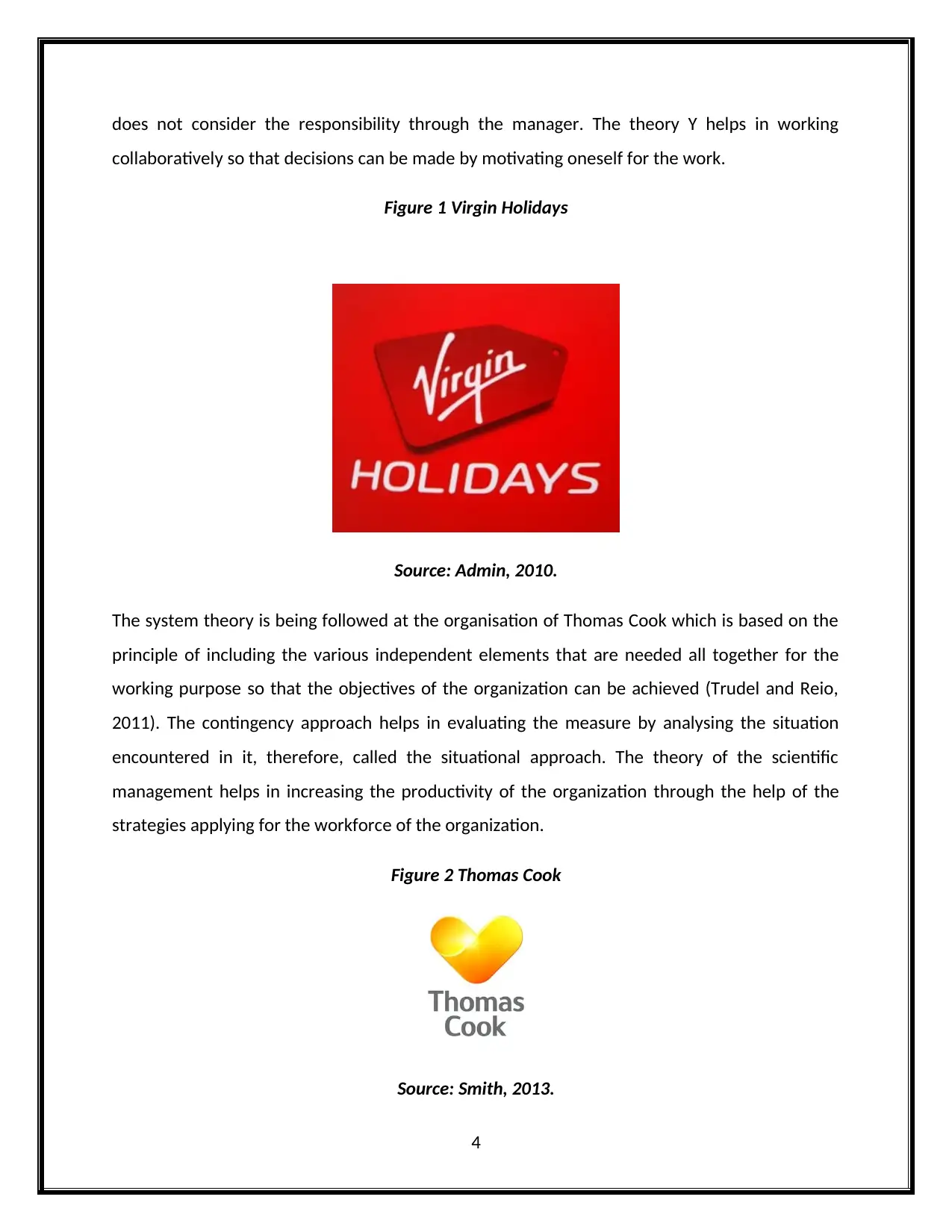
does not consider the responsibility through the manager. The theory Y helps in working
collaboratively so that decisions can be made by motivating oneself for the work.
Figure 1 Virgin Holidays
Source: Admin, 2010.
The system theory is being followed at the organisation of Thomas Cook which is based on the
principle of including the various independent elements that are needed all together for the
working purpose so that the objectives of the organization can be achieved (Trudel and Reio,
2011). The contingency approach helps in evaluating the measure by analysing the situation
encountered in it, therefore, called the situational approach. The theory of the scientific
management helps in increasing the productivity of the organization through the help of the
strategies applying for the workforce of the organization.
Figure 2 Thomas Cook
Source: Smith, 2013.
4
collaboratively so that decisions can be made by motivating oneself for the work.
Figure 1 Virgin Holidays
Source: Admin, 2010.
The system theory is being followed at the organisation of Thomas Cook which is based on the
principle of including the various independent elements that are needed all together for the
working purpose so that the objectives of the organization can be achieved (Trudel and Reio,
2011). The contingency approach helps in evaluating the measure by analysing the situation
encountered in it, therefore, called the situational approach. The theory of the scientific
management helps in increasing the productivity of the organization through the help of the
strategies applying for the workforce of the organization.
Figure 2 Thomas Cook
Source: Smith, 2013.
4
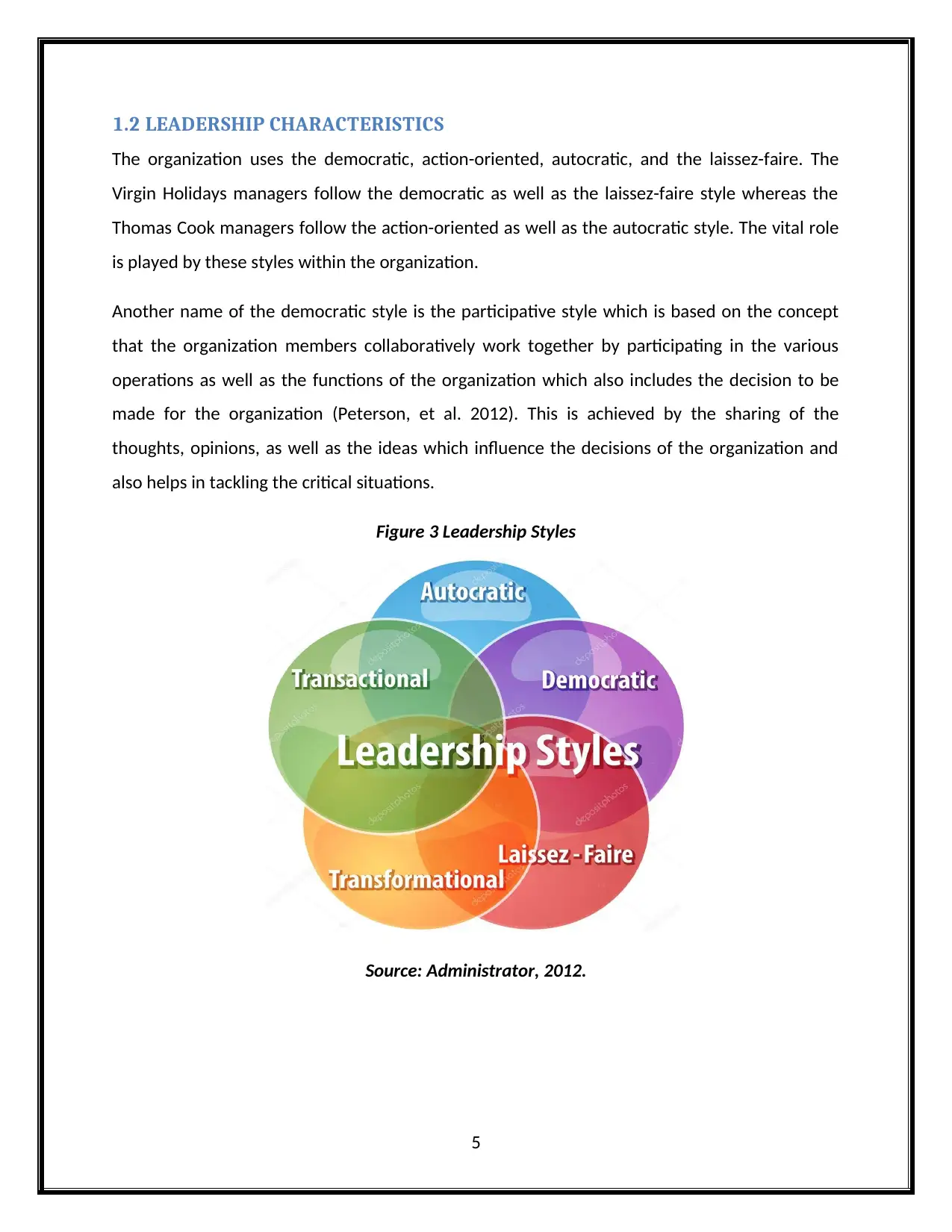
1.2 LEADERSHIP CHARACTERISTICS
The organization uses the democratic, action-oriented, autocratic, and the laissez-faire. The
Virgin Holidays managers follow the democratic as well as the laissez-faire style whereas the
Thomas Cook managers follow the action-oriented as well as the autocratic style. The vital role
is played by these styles within the organization.
Another name of the democratic style is the participative style which is based on the concept
that the organization members collaboratively work together by participating in the various
operations as well as the functions of the organization which also includes the decision to be
made for the organization (Peterson, et al. 2012). This is achieved by the sharing of the
thoughts, opinions, as well as the ideas which influence the decisions of the organization and
also helps in tackling the critical situations.
Figure 3 Leadership Styles
Source: Administrator, 2012.
5
The organization uses the democratic, action-oriented, autocratic, and the laissez-faire. The
Virgin Holidays managers follow the democratic as well as the laissez-faire style whereas the
Thomas Cook managers follow the action-oriented as well as the autocratic style. The vital role
is played by these styles within the organization.
Another name of the democratic style is the participative style which is based on the concept
that the organization members collaboratively work together by participating in the various
operations as well as the functions of the organization which also includes the decision to be
made for the organization (Peterson, et al. 2012). This is achieved by the sharing of the
thoughts, opinions, as well as the ideas which influence the decisions of the organization and
also helps in tackling the critical situations.
Figure 3 Leadership Styles
Source: Administrator, 2012.
5
⊘ This is a preview!⊘
Do you want full access?
Subscribe today to unlock all pages.

Trusted by 1+ million students worldwide
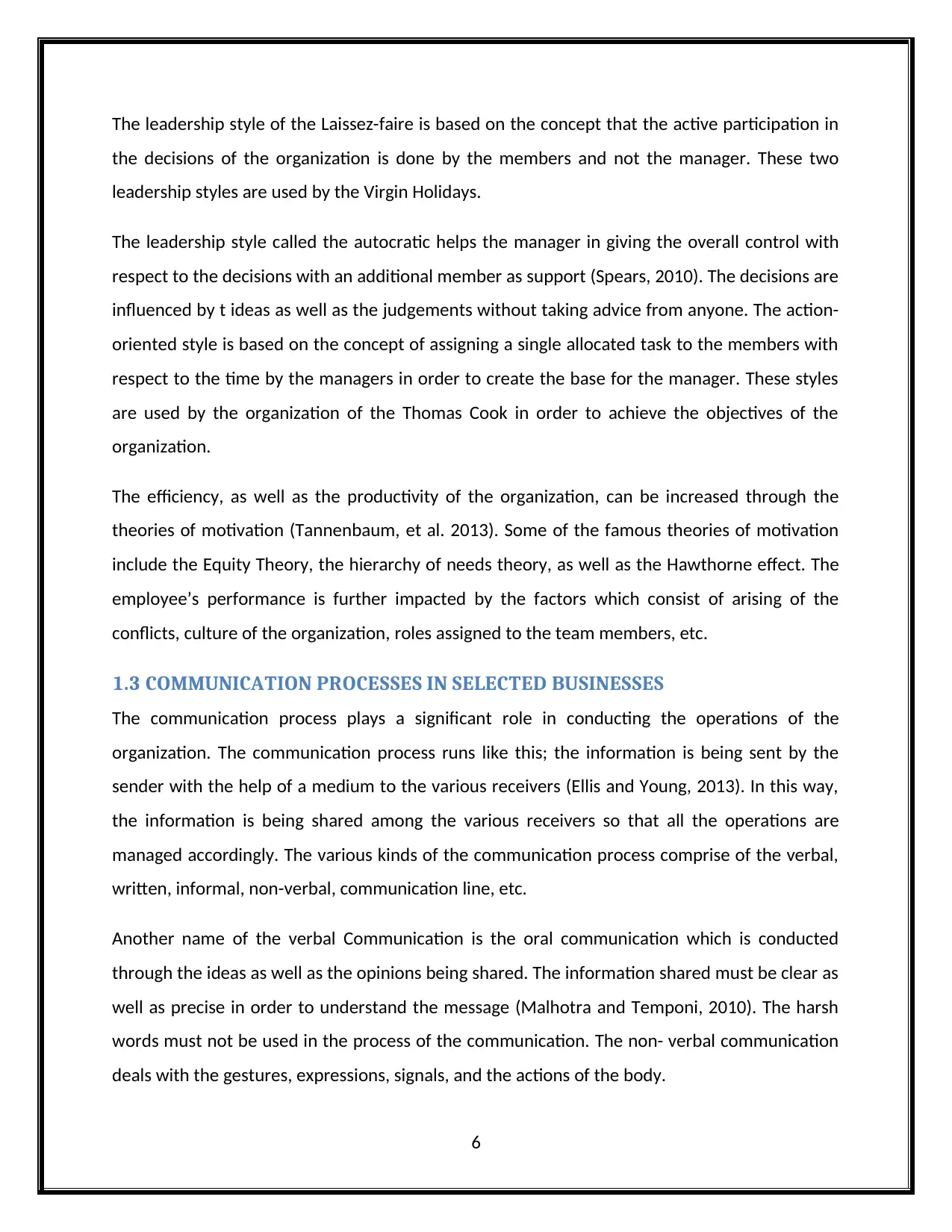
The leadership style of the Laissez-faire is based on the concept that the active participation in
the decisions of the organization is done by the members and not the manager. These two
leadership styles are used by the Virgin Holidays.
The leadership style called the autocratic helps the manager in giving the overall control with
respect to the decisions with an additional member as support (Spears, 2010). The decisions are
influenced by t ideas as well as the judgements without taking advice from anyone. The action-
oriented style is based on the concept of assigning a single allocated task to the members with
respect to the time by the managers in order to create the base for the manager. These styles
are used by the organization of the Thomas Cook in order to achieve the objectives of the
organization.
The efficiency, as well as the productivity of the organization, can be increased through the
theories of motivation (Tannenbaum, et al. 2013). Some of the famous theories of motivation
include the Equity Theory, the hierarchy of needs theory, as well as the Hawthorne effect. The
employee’s performance is further impacted by the factors which consist of arising of the
conflicts, culture of the organization, roles assigned to the team members, etc.
1.3 COMMUNICATION PROCESSES IN SELECTED BUSINESSES
The communication process plays a significant role in conducting the operations of the
organization. The communication process runs like this; the information is being sent by the
sender with the help of a medium to the various receivers (Ellis and Young, 2013). In this way,
the information is being shared among the various receivers so that all the operations are
managed accordingly. The various kinds of the communication process comprise of the verbal,
written, informal, non-verbal, communication line, etc.
Another name of the verbal Communication is the oral communication which is conducted
through the ideas as well as the opinions being shared. The information shared must be clear as
well as precise in order to understand the message (Malhotra and Temponi, 2010). The harsh
words must not be used in the process of the communication. The non- verbal communication
deals with the gestures, expressions, signals, and the actions of the body.
6
the decisions of the organization is done by the members and not the manager. These two
leadership styles are used by the Virgin Holidays.
The leadership style called the autocratic helps the manager in giving the overall control with
respect to the decisions with an additional member as support (Spears, 2010). The decisions are
influenced by t ideas as well as the judgements without taking advice from anyone. The action-
oriented style is based on the concept of assigning a single allocated task to the members with
respect to the time by the managers in order to create the base for the manager. These styles
are used by the organization of the Thomas Cook in order to achieve the objectives of the
organization.
The efficiency, as well as the productivity of the organization, can be increased through the
theories of motivation (Tannenbaum, et al. 2013). Some of the famous theories of motivation
include the Equity Theory, the hierarchy of needs theory, as well as the Hawthorne effect. The
employee’s performance is further impacted by the factors which consist of arising of the
conflicts, culture of the organization, roles assigned to the team members, etc.
1.3 COMMUNICATION PROCESSES IN SELECTED BUSINESSES
The communication process plays a significant role in conducting the operations of the
organization. The communication process runs like this; the information is being sent by the
sender with the help of a medium to the various receivers (Ellis and Young, 2013). In this way,
the information is being shared among the various receivers so that all the operations are
managed accordingly. The various kinds of the communication process comprise of the verbal,
written, informal, non-verbal, communication line, etc.
Another name of the verbal Communication is the oral communication which is conducted
through the ideas as well as the opinions being shared. The information shared must be clear as
well as precise in order to understand the message (Malhotra and Temponi, 2010). The harsh
words must not be used in the process of the communication. The non- verbal communication
deals with the gestures, expressions, signals, and the actions of the body.
6
Paraphrase This Document
Need a fresh take? Get an instant paraphrase of this document with our AI Paraphraser
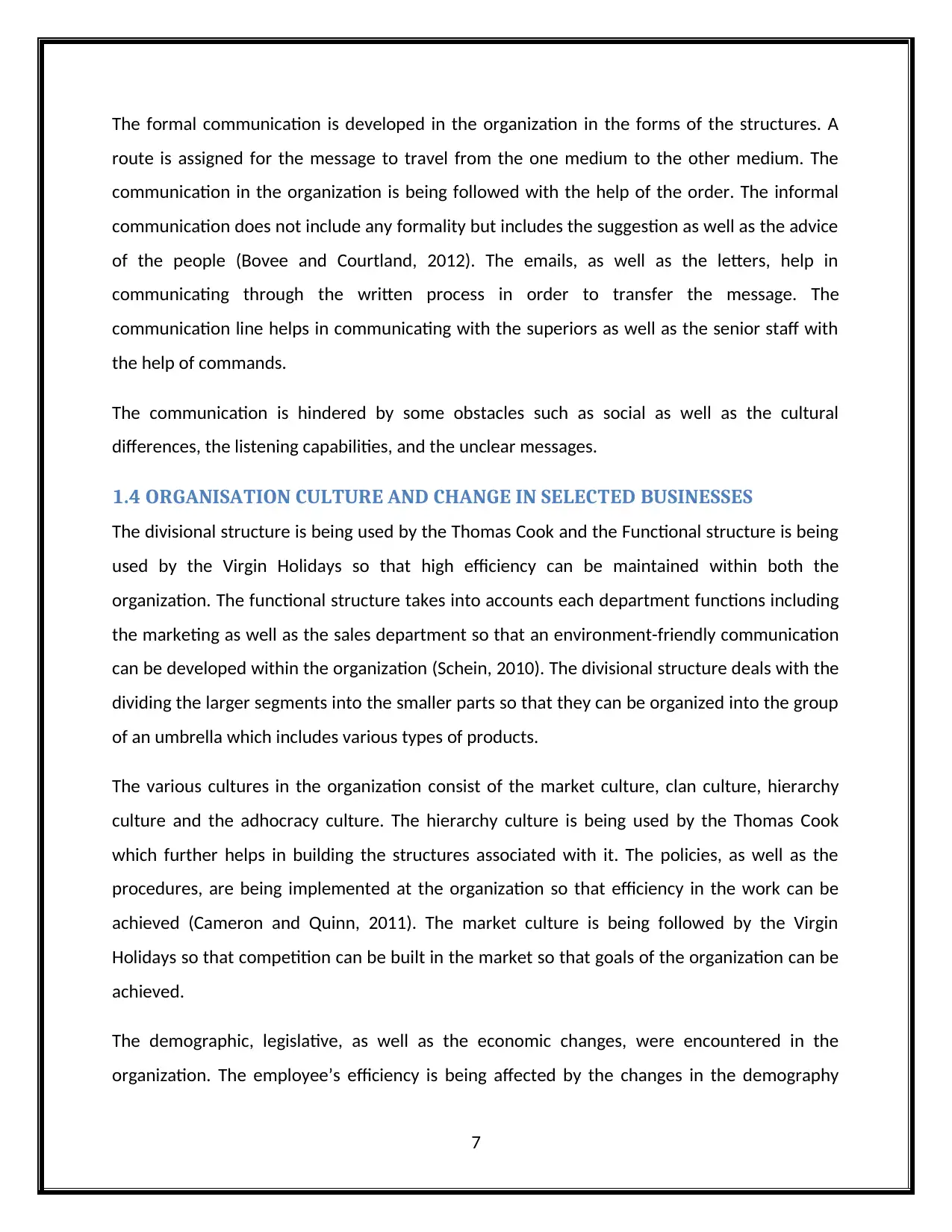
The formal communication is developed in the organization in the forms of the structures. A
route is assigned for the message to travel from the one medium to the other medium. The
communication in the organization is being followed with the help of the order. The informal
communication does not include any formality but includes the suggestion as well as the advice
of the people (Bovee and Courtland, 2012). The emails, as well as the letters, help in
communicating through the written process in order to transfer the message. The
communication line helps in communicating with the superiors as well as the senior staff with
the help of commands.
The communication is hindered by some obstacles such as social as well as the cultural
differences, the listening capabilities, and the unclear messages.
1.4 ORGANISATION CULTURE AND CHANGE IN SELECTED BUSINESSES
The divisional structure is being used by the Thomas Cook and the Functional structure is being
used by the Virgin Holidays so that high efficiency can be maintained within both the
organization. The functional structure takes into accounts each department functions including
the marketing as well as the sales department so that an environment-friendly communication
can be developed within the organization (Schein, 2010). The divisional structure deals with the
dividing the larger segments into the smaller parts so that they can be organized into the group
of an umbrella which includes various types of products.
The various cultures in the organization consist of the market culture, clan culture, hierarchy
culture and the adhocracy culture. The hierarchy culture is being used by the Thomas Cook
which further helps in building the structures associated with it. The policies, as well as the
procedures, are being implemented at the organization so that efficiency in the work can be
achieved (Cameron and Quinn, 2011). The market culture is being followed by the Virgin
Holidays so that competition can be built in the market so that goals of the organization can be
achieved.
The demographic, legislative, as well as the economic changes, were encountered in the
organization. The employee’s efficiency is being affected by the changes in the demography
7
route is assigned for the message to travel from the one medium to the other medium. The
communication in the organization is being followed with the help of the order. The informal
communication does not include any formality but includes the suggestion as well as the advice
of the people (Bovee and Courtland, 2012). The emails, as well as the letters, help in
communicating through the written process in order to transfer the message. The
communication line helps in communicating with the superiors as well as the senior staff with
the help of commands.
The communication is hindered by some obstacles such as social as well as the cultural
differences, the listening capabilities, and the unclear messages.
1.4 ORGANISATION CULTURE AND CHANGE IN SELECTED BUSINESSES
The divisional structure is being used by the Thomas Cook and the Functional structure is being
used by the Virgin Holidays so that high efficiency can be maintained within both the
organization. The functional structure takes into accounts each department functions including
the marketing as well as the sales department so that an environment-friendly communication
can be developed within the organization (Schein, 2010). The divisional structure deals with the
dividing the larger segments into the smaller parts so that they can be organized into the group
of an umbrella which includes various types of products.
The various cultures in the organization consist of the market culture, clan culture, hierarchy
culture and the adhocracy culture. The hierarchy culture is being used by the Thomas Cook
which further helps in building the structures associated with it. The policies, as well as the
procedures, are being implemented at the organization so that efficiency in the work can be
achieved (Cameron and Quinn, 2011). The market culture is being followed by the Virgin
Holidays so that competition can be built in the market so that goals of the organization can be
achieved.
The demographic, legislative, as well as the economic changes, were encountered in the
organization. The employee’s efficiency is being affected by the changes in the demography
7
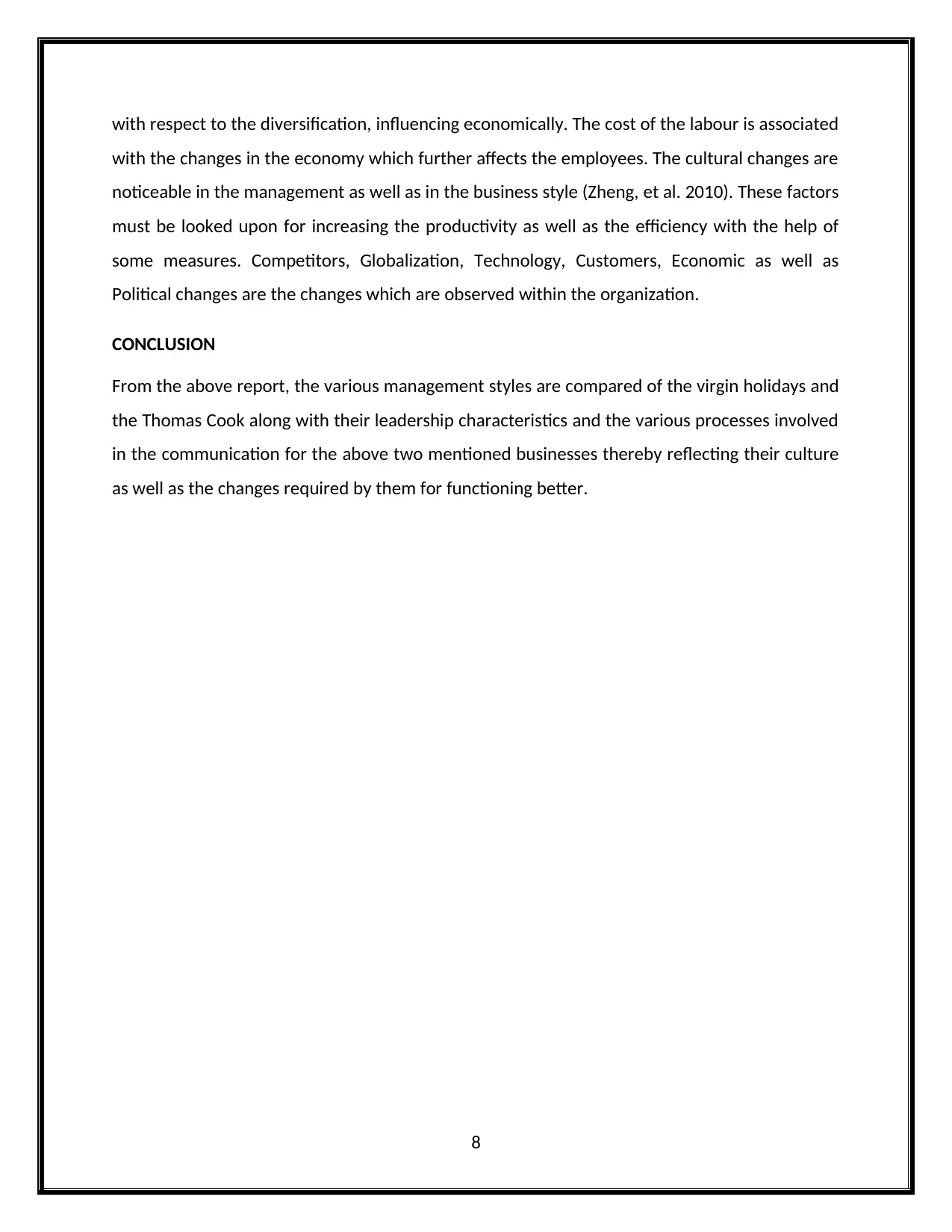
with respect to the diversification, influencing economically. The cost of the labour is associated
with the changes in the economy which further affects the employees. The cultural changes are
noticeable in the management as well as in the business style (Zheng, et al. 2010). These factors
must be looked upon for increasing the productivity as well as the efficiency with the help of
some measures. Competitors, Globalization, Technology, Customers, Economic as well as
Political changes are the changes which are observed within the organization.
CONCLUSION
From the above report, the various management styles are compared of the virgin holidays and
the Thomas Cook along with their leadership characteristics and the various processes involved
in the communication for the above two mentioned businesses thereby reflecting their culture
as well as the changes required by them for functioning better.
8
with the changes in the economy which further affects the employees. The cultural changes are
noticeable in the management as well as in the business style (Zheng, et al. 2010). These factors
must be looked upon for increasing the productivity as well as the efficiency with the help of
some measures. Competitors, Globalization, Technology, Customers, Economic as well as
Political changes are the changes which are observed within the organization.
CONCLUSION
From the above report, the various management styles are compared of the virgin holidays and
the Thomas Cook along with their leadership characteristics and the various processes involved
in the communication for the above two mentioned businesses thereby reflecting their culture
as well as the changes required by them for functioning better.
8
⊘ This is a preview!⊘
Do you want full access?
Subscribe today to unlock all pages.

Trusted by 1+ million students worldwide
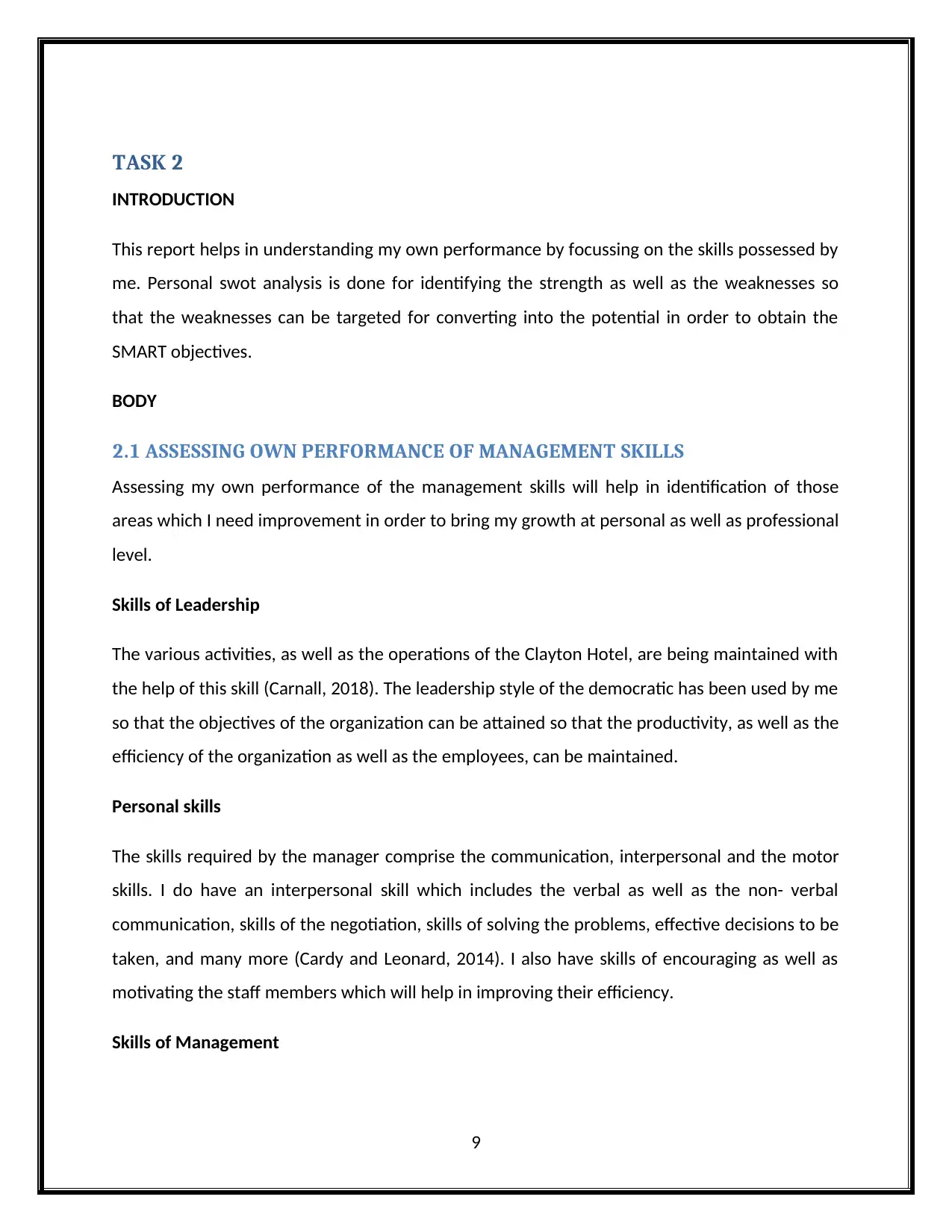
TASK 2
INTRODUCTION
This report helps in understanding my own performance by focussing on the skills possessed by
me. Personal swot analysis is done for identifying the strength as well as the weaknesses so
that the weaknesses can be targeted for converting into the potential in order to obtain the
SMART objectives.
BODY
2.1 ASSESSING OWN PERFORMANCE OF MANAGEMENT SKILLS
Assessing my own performance of the management skills will help in identification of those
areas which I need improvement in order to bring my growth at personal as well as professional
level.
Skills of Leadership
The various activities, as well as the operations of the Clayton Hotel, are being maintained with
the help of this skill (Carnall, 2018). The leadership style of the democratic has been used by me
so that the objectives of the organization can be attained so that the productivity, as well as the
efficiency of the organization as well as the employees, can be maintained.
Personal skills
The skills required by the manager comprise the communication, interpersonal and the motor
skills. I do have an interpersonal skill which includes the verbal as well as the non- verbal
communication, skills of the negotiation, skills of solving the problems, effective decisions to be
taken, and many more (Cardy and Leonard, 2014). I also have skills of encouraging as well as
motivating the staff members which will help in improving their efficiency.
Skills of Management
9
INTRODUCTION
This report helps in understanding my own performance by focussing on the skills possessed by
me. Personal swot analysis is done for identifying the strength as well as the weaknesses so
that the weaknesses can be targeted for converting into the potential in order to obtain the
SMART objectives.
BODY
2.1 ASSESSING OWN PERFORMANCE OF MANAGEMENT SKILLS
Assessing my own performance of the management skills will help in identification of those
areas which I need improvement in order to bring my growth at personal as well as professional
level.
Skills of Leadership
The various activities, as well as the operations of the Clayton Hotel, are being maintained with
the help of this skill (Carnall, 2018). The leadership style of the democratic has been used by me
so that the objectives of the organization can be attained so that the productivity, as well as the
efficiency of the organization as well as the employees, can be maintained.
Personal skills
The skills required by the manager comprise the communication, interpersonal and the motor
skills. I do have an interpersonal skill which includes the verbal as well as the non- verbal
communication, skills of the negotiation, skills of solving the problems, effective decisions to be
taken, and many more (Cardy and Leonard, 2014). I also have skills of encouraging as well as
motivating the staff members which will help in improving their efficiency.
Skills of Management
9
Paraphrase This Document
Need a fresh take? Get an instant paraphrase of this document with our AI Paraphraser
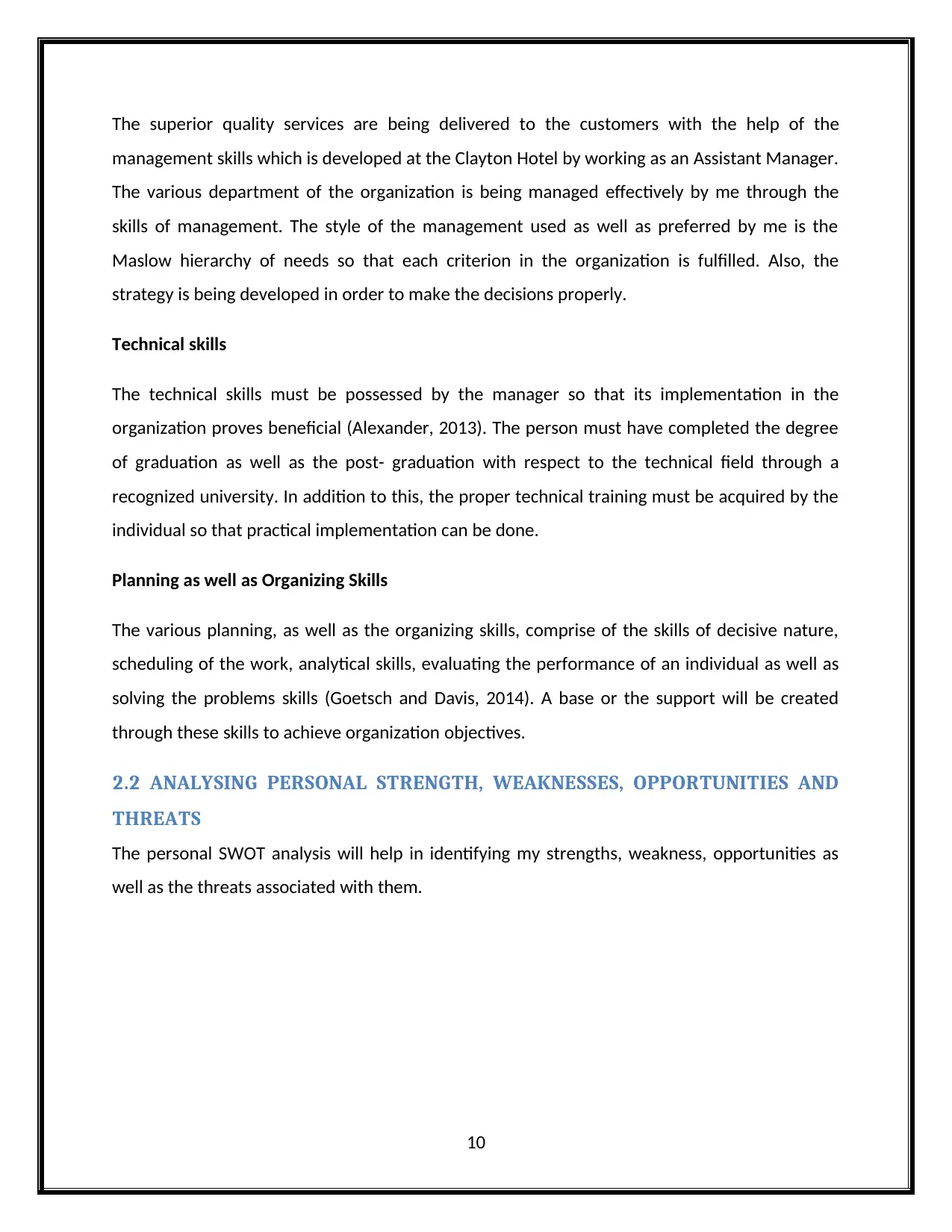
The superior quality services are being delivered to the customers with the help of the
management skills which is developed at the Clayton Hotel by working as an Assistant Manager.
The various department of the organization is being managed effectively by me through the
skills of management. The style of the management used as well as preferred by me is the
Maslow hierarchy of needs so that each criterion in the organization is fulfilled. Also, the
strategy is being developed in order to make the decisions properly.
Technical skills
The technical skills must be possessed by the manager so that its implementation in the
organization proves beneficial (Alexander, 2013). The person must have completed the degree
of graduation as well as the post- graduation with respect to the technical field through a
recognized university. In addition to this, the proper technical training must be acquired by the
individual so that practical implementation can be done.
Planning as well as Organizing Skills
The various planning, as well as the organizing skills, comprise of the skills of decisive nature,
scheduling of the work, analytical skills, evaluating the performance of an individual as well as
solving the problems skills (Goetsch and Davis, 2014). A base or the support will be created
through these skills to achieve organization objectives.
2.2 ANALYSING PERSONAL STRENGTH, WEAKNESSES, OPPORTUNITIES AND
THREATS
The personal SWOT analysis will help in identifying my strengths, weakness, opportunities as
well as the threats associated with them.
10
management skills which is developed at the Clayton Hotel by working as an Assistant Manager.
The various department of the organization is being managed effectively by me through the
skills of management. The style of the management used as well as preferred by me is the
Maslow hierarchy of needs so that each criterion in the organization is fulfilled. Also, the
strategy is being developed in order to make the decisions properly.
Technical skills
The technical skills must be possessed by the manager so that its implementation in the
organization proves beneficial (Alexander, 2013). The person must have completed the degree
of graduation as well as the post- graduation with respect to the technical field through a
recognized university. In addition to this, the proper technical training must be acquired by the
individual so that practical implementation can be done.
Planning as well as Organizing Skills
The various planning, as well as the organizing skills, comprise of the skills of decisive nature,
scheduling of the work, analytical skills, evaluating the performance of an individual as well as
solving the problems skills (Goetsch and Davis, 2014). A base or the support will be created
through these skills to achieve organization objectives.
2.2 ANALYSING PERSONAL STRENGTH, WEAKNESSES, OPPORTUNITIES AND
THREATS
The personal SWOT analysis will help in identifying my strengths, weakness, opportunities as
well as the threats associated with them.
10
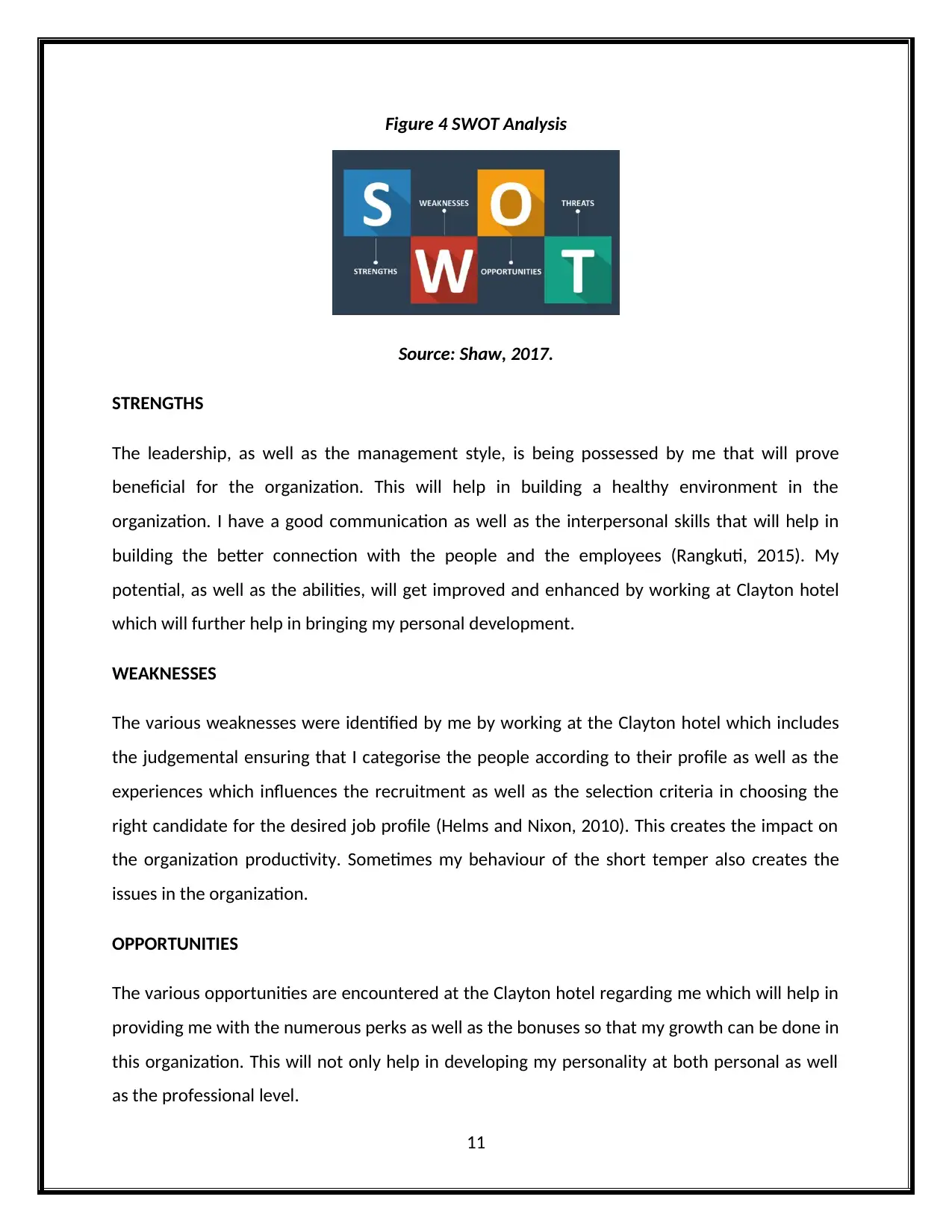
Figure 4 SWOT Analysis
Source: Shaw, 2017.
STRENGTHS
The leadership, as well as the management style, is being possessed by me that will prove
beneficial for the organization. This will help in building a healthy environment in the
organization. I have a good communication as well as the interpersonal skills that will help in
building the better connection with the people and the employees (Rangkuti, 2015). My
potential, as well as the abilities, will get improved and enhanced by working at Clayton hotel
which will further help in bringing my personal development.
WEAKNESSES
The various weaknesses were identified by me by working at the Clayton hotel which includes
the judgemental ensuring that I categorise the people according to their profile as well as the
experiences which influences the recruitment as well as the selection criteria in choosing the
right candidate for the desired job profile (Helms and Nixon, 2010). This creates the impact on
the organization productivity. Sometimes my behaviour of the short temper also creates the
issues in the organization.
OPPORTUNITIES
The various opportunities are encountered at the Clayton hotel regarding me which will help in
providing me with the numerous perks as well as the bonuses so that my growth can be done in
this organization. This will not only help in developing my personality at both personal as well
as the professional level.
11
Source: Shaw, 2017.
STRENGTHS
The leadership, as well as the management style, is being possessed by me that will prove
beneficial for the organization. This will help in building a healthy environment in the
organization. I have a good communication as well as the interpersonal skills that will help in
building the better connection with the people and the employees (Rangkuti, 2015). My
potential, as well as the abilities, will get improved and enhanced by working at Clayton hotel
which will further help in bringing my personal development.
WEAKNESSES
The various weaknesses were identified by me by working at the Clayton hotel which includes
the judgemental ensuring that I categorise the people according to their profile as well as the
experiences which influences the recruitment as well as the selection criteria in choosing the
right candidate for the desired job profile (Helms and Nixon, 2010). This creates the impact on
the organization productivity. Sometimes my behaviour of the short temper also creates the
issues in the organization.
OPPORTUNITIES
The various opportunities are encountered at the Clayton hotel regarding me which will help in
providing me with the numerous perks as well as the bonuses so that my growth can be done in
this organization. This will not only help in developing my personality at both personal as well
as the professional level.
11
⊘ This is a preview!⊘
Do you want full access?
Subscribe today to unlock all pages.

Trusted by 1+ million students worldwide
1 out of 24
Related Documents
Your All-in-One AI-Powered Toolkit for Academic Success.
+13062052269
info@desklib.com
Available 24*7 on WhatsApp / Email
![[object Object]](/_next/static/media/star-bottom.7253800d.svg)
Unlock your academic potential
Copyright © 2020–2025 A2Z Services. All Rights Reserved. Developed and managed by ZUCOL.




